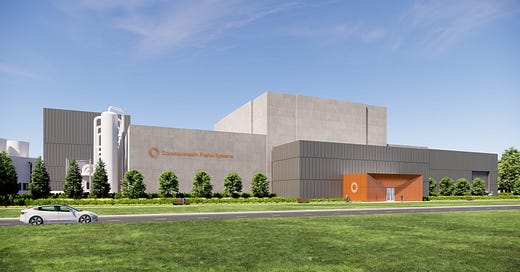A commercial fusion power plant by the early 2030s?
A materials scientist's look at Commonwealth Fusion Systems' most recent announcement
Yesterday, Commonwealth Fusion System announced plans to build its first ARC fusion power plant in Chesterfield County, Va. in the early 2030s. From the perspective of materials technology, the early 2030s target date looks very ambitious.
A big goal
Commonwealth Fusion Systems (CFS), a spinoff from the MIT Plasma Science and Fusion Center, intends to produce 400 MW of steady power into the electrical grid starting in the early 2030s. This is an ambitious goal that — if successful — would mark the first time that fusion energy provides net electricity at grid scale.
This first power plant would follow in the footsteps of the SPARC proof of concept device that the company is actively building and that is expected to start operating in 2027.
CFS isn’t the only fusion company targeting a commercial power plant within a decade. Helion Energy, backed by OpenAI CEO Sam Altman, claims that it will deliver a fusion power plant by 2028 —an even more ambitious timeline that has left many scientists scratching their heads. More realistically, China is aggressively pursuing its own fusion energy roadmap, investing billions of dollars into development efforts aimed at a 1 GW test plant in the 2030s.
The materials for ARC don’t exist yet
Existing materials (such as tungsten and specialty low-activation steels) will probably be robust enough for early demonstration devices like SPARC. But there is a general consensus that the materials required for a real power plant such as ARC —which must operate over several decades without significant downtime —simply do not exist today.
This is because the working environment for materials inside a fusion power plant is uniquely harsh, with materials challenges that far exceed those for other energy technologies, including nuclear fission reactors.

Recently several MIT researchers and I investigated the unsolved materials challenges for commercial fusion plants. Our findings are summarized in a perspective article in the journal Matter (click here to read).
In summary, we found that economically viable fusion power plants will require not only new materials for plasma-facing components, magnets, and blankets, but also for less-studied subsystems, such as those for the fuel cycle, heat exchangers, sensors, insulating components, functional materials, and those for maintenance. Without these new materials, it simply won’t be possible to operate a commercially viable power plant.
An ARC power plant by the early 2030s?
Will CFS really succeed in launching a fusion power plant in the 2030s? Optimistically, yes —for the sake of our energy system, let’s hope so!
Will this first ARC really deliver steady power to the grid? Probably not. Steady operation requires new materials that simply don’t exist today, and it’s exceedingly hard to imagine that those materials would be developed, qualified, and produced at scale in time for the first ARC.
Will it really be the early 2030s? Again, probably not. Building anything for the first time takes a long time, and here we are talking about an extremely complex system with many interrelated parts, billions of dollars worth of construction and equipment, and supply chains that simply don’t exist today.
A potential timeline
Comparing the early trajectory of fusion energy with the historical trajectory of civilian aviation technology, we arrived at the following optimistic “best guess” for a timeline to widespread fusion energy:

Either way, in this timeline, the first few ARC plants of the 2030s will probably be pilot and first-of-a-kind plants, and wouldn’t be expected to operate at high capacity factor (“steady power”) or be economically viable — in large part because the materials probably won’t be ready by the 2030s. Only in the 2040s would we begin to see a first fleet of commercially viable fusion power plants that can deliver steady power and operate at a profit.
An exciting road ahead
Disruptive technological innovation takes time, and fusion is a bold and complex endeavor that could change the world if it works. It’s exciting that CFS has selected a site for its first power plant, and that the company feels confident enough to state such an ambitious delivery date. Even so, it’s a good idea to take some of these goals (early 2030s launch date, “steady” power output) with a grain of salt.
As a materials scientist, I am especially excited about the potential of AI and “self-driving labs” to dramatically accelerate the pace of materials development for fusion.
It’s time for materials scientists & engineers to get to work!
See article: David Cohen-Tanugi, Myles G. Stapelberg, Michael P. Short, Sara E. Ferry, Dennis G. Whyte, Zachary S. Hartwig, Tonio Buonassisi. ‘Long-term research and design strategies for fusion energy materials,’ Matter (December 2024)
Author’s note: Although this analysis builds upon a collaborative research project with MIT colleagues, the views expressed in this article are my own.





